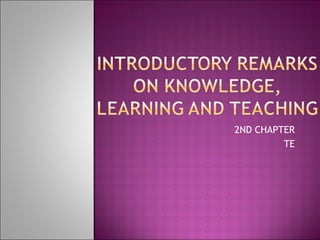INTRODUCTORY REMARKS ON KNOWLEDGE, LEARNING AND TEACHING
•Als PPT, PDF herunterladen•
0 gefällt mir•1,118 views
This document discusses different perspectives on teaching and learning, including epistemology, constructivism, behaviorism, cognitivism, and learner-centered approaches. It also addresses using technology to accommodate different learning styles and enhancing student engagement through interactive media like animation, graphics, and games.
Melden
Teilen
Melden
Teilen

Empfohlen
Weitere ähnliche Inhalte
Was ist angesagt?
Was ist angesagt? (20)
Learning theories related to educational technology

Learning theories related to educational technology
Beyond Constructionist thinking - 4 all MA and PHD students Curriculum and In...

Beyond Constructionist thinking - 4 all MA and PHD students Curriculum and In...
The importance of understanding the learning process when trying to improve p...

The importance of understanding the learning process when trying to improve p...
Ähnlich wie INTRODUCTORY REMARKS ON KNOWLEDGE, LEARNING AND TEACHING
INNOVATION OF LEARNING IN THE EUROPEAN FRAMEWORK OF EDUCATION AT UNIVERSITIES...

INNOVATION OF LEARNING IN THE EUROPEAN FRAMEWORK OF EDUCATION AT UNIVERSITIES...University of Jaén-Psychology
Ähnlich wie INTRODUCTORY REMARKS ON KNOWLEDGE, LEARNING AND TEACHING (20)
WebQuest: "The World Through a Different Pair of Eyes"

WebQuest: "The World Through a Different Pair of Eyes"
INNOVATION OF LEARNING IN THE EUROPEAN FRAMEWORK OF EDUCATION AT UNIVERSITIES...

INNOVATION OF LEARNING IN THE EUROPEAN FRAMEWORK OF EDUCATION AT UNIVERSITIES...
Role and functions of educational technology in the 21ST CENTURY EDUCATION

Role and functions of educational technology in the 21ST CENTURY EDUCATION
Educational technology vis a-vis models of learning

Educational technology vis a-vis models of learning
INTEGRATION OF INNOVATIE TEACHING PRACTICES IN TEACHING AND LEARNING PROCESS

INTEGRATION OF INNOVATIE TEACHING PRACTICES IN TEACHING AND LEARNING PROCESS
CONSTRUCTIVIST APPROACH TO LEARNING Method- 5E MODEL-PPT

CONSTRUCTIVIST APPROACH TO LEARNING Method- 5E MODEL-PPT
21ST CENTURY SKILLS AND ICT INTEGRATION IN INSTRUCTION18.pptx

21ST CENTURY SKILLS AND ICT INTEGRATION IN INSTRUCTION18.pptx
LAC SESSION ON 21ST CENTURY SKILLSN AND ICT INTEGRATION IN EDUCATION.pdf

LAC SESSION ON 21ST CENTURY SKILLSN AND ICT INTEGRATION IN EDUCATION.pdf
A Synthesis of Self-directed Learning Design Model with Constructionism in t...

A Synthesis of Self-directed Learning Design Model with Constructionism in t...
Mehr von izaherna
Mehr von izaherna (10)
INTRODUCTORY REMARKS ON KNOWLEDGE, LEARNING AND TEACHING

INTRODUCTORY REMARKS ON KNOWLEDGE, LEARNING AND TEACHING
The Use Of Weblogs As A Resource For Knowledge Construction In Virtual Enviro...

The Use Of Weblogs As A Resource For Knowledge Construction In Virtual Enviro...
Kürzlich hochgeladen
Mehran University Newsletter Vol-X, Issue-I, 2024

Mehran University Newsletter Vol-X, Issue-I, 2024Mehran University of Engineering & Technology, Jamshoro
Explore beautiful and ugly buildings. Mathematics helps us create beautiful d...

Explore beautiful and ugly buildings. Mathematics helps us create beautiful d...christianmathematics
Kürzlich hochgeladen (20)
SECOND SEMESTER TOPIC COVERAGE SY 2023-2024 Trends, Networks, and Critical Th...

SECOND SEMESTER TOPIC COVERAGE SY 2023-2024 Trends, Networks, and Critical Th...
Unit-IV; Professional Sales Representative (PSR).pptx

Unit-IV; Professional Sales Representative (PSR).pptx
Z Score,T Score, Percential Rank and Box Plot Graph

Z Score,T Score, Percential Rank and Box Plot Graph
Web & Social Media Analytics Previous Year Question Paper.pdf

Web & Social Media Analytics Previous Year Question Paper.pdf
Ecological Succession. ( ECOSYSTEM, B. Pharmacy, 1st Year, Sem-II, Environmen...

Ecological Succession. ( ECOSYSTEM, B. Pharmacy, 1st Year, Sem-II, Environmen...
Mixin Classes in Odoo 17 How to Extend Models Using Mixin Classes

Mixin Classes in Odoo 17 How to Extend Models Using Mixin Classes
Explore beautiful and ugly buildings. Mathematics helps us create beautiful d...

Explore beautiful and ugly buildings. Mathematics helps us create beautiful d...
Measures of Central Tendency: Mean, Median and Mode

Measures of Central Tendency: Mean, Median and Mode